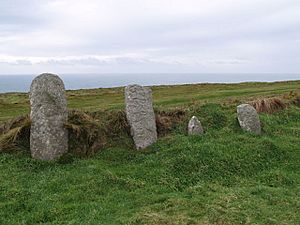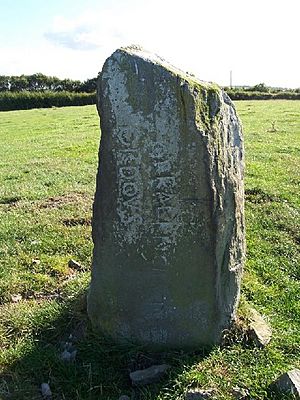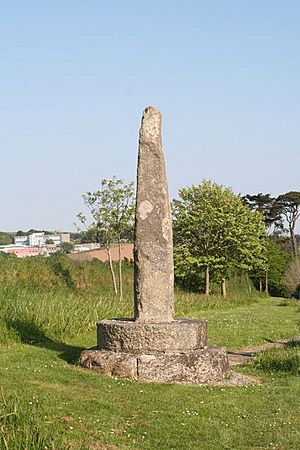Celtic inscribed stone facts for kids

Celtic inscribed stones are old stone monuments created between 400 and 1000 AD. These stones have special messages carved into them. The messages are usually in ancient Celtic or Latin. Sometimes they use a unique alphabet called Ogham. Other times, they use regular Roman letters. Some stones even have both! You can find these stones in places like Ireland, Scotland, Wales, Brittany (in France), the Isle of Man, and parts of western England (especially Cornwall, Devon, and Lundy Island). Most of these stones were used as grave markers or memorials for people who had died.
A project called the Celtic Inscribed Stones Project has recorded over 1,200 of these inscriptions. They have an online database where you can learn more about them. These stones are similar to other ancient standing stones that have pictures, like the Pictish stones in Scotland. They also resemble stones with abstract designs, such as the much older Irish Turoe Stone and Castlestrange Stone.
Contents
Ancient Stones in Cornwall
Many interesting inscribed stones have been found in Cornwall, a county in southwest England.
East Cornwall Stones
The Tristan Stone is an old stone from around 550 AD. It is now near Fowey, but it used to be closer to the harbour at Polkerris. One side of the stone has a cross shape. Another side has a Latin message that says:
DRVSTANVS HIC IACIT
CVNOMORI FILIVS
This means: Drustanus lies here, son of Cunomorus.
Not far from Worthyvale, in the area of Minster, there is another inscribed stone. Its Latin message means: "Latin son of Macarus lies here." This stone is often called King Arthur's Grave by local people. This is because some people wrongly thought that a nearby place, Slaughterbridge, was where the famous Battle of Camlann happened.
West Cornwall Stones
The Mên Scryfa is a stone with Latin writing. It might have been added to a much older large stone called a megalith.
The Selus Stone dates from the late 400s or early 500s. It has a Latin message that says: "Selus Ic Iacet" (Selus lies here). People believe this refers to Salomon of Cornwall, also known as Saint Selevan. You can see this stone at St Just in Penwith Parish Church.
In the church at Cuby, there is an inscribed stone from the 500s or 600s. Its message is a bit harder to read but mentions "Nonnita Ercilini Rigati."
The churchyard of St Clement has an inscribed stone cross. The message on it is "Ignioc Vitali fili Torrici." This means "Ignioc son of Vitalus son of Torricus." This stone is from between the 400s and 600s. It also has some writing in Ogham, which might be partly in Irish. The messages were carved before the top of the stone was shaped into a cross.
An inscribed stone from the 500s to 700s was found built into the walls of the 1400s church at Cubert. It has the name "Cenetocus, son of Tegernomalus" carved on it.
Gallery of Cornish Stones
Ancient Stones in Wales

In a field between Penbryn and Tresaith in Ceredigion, Wales, stands the 6th-century Corbalengi Stone. This tall stone is about 1.4 meters high. It is believed to be from the time after the Romans left Britain. The stone has the message "CORBALENGI IACIT ORDOVS" carved on it.
The stone was first noticed by Edward Lhywd in 1695. He said it was in a field near the church. It was originally found with a pile of smaller stones. Underneath these stones, an urn with ashes and some Roman coins were discovered. The last word of the message, 'Ordovs' (after "IACIT," which means "lies"), is thought to refer to the Ordovices tribe from North Wales. This suggests the stone was carved by local tribes to honor a member of the Ordovices who had settled in the area.
Other ideas about the message include "Cor Balenci jacit Ordous," meaning "The Heart of Balengus the Ordovician lies here." Another idea is "CORBALENGI LACIT ORDOVS," where "Lacit" means "thrashed" instead of "lies." If this is true, it might refer to a battle between the Ordovices and a group called the "Corbalengi." While the Ordovices tribe is well known, no other records of a "Corbalengi" tribe have been found.





